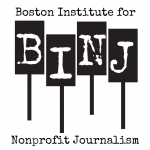Photo of Ana Masacote by Enrique Yaptenco
Pro dancer Ana Masacote opens up about being bisexual in the salsa scene
“I don’t consider myself an activist. I consider myself a person who is no longer afraid to be herself. I hope one day that that is not such a radical idea.”
That’s how Boston-based salsa celebrity Ana Masacote reacts when asked about her coming out as bisexual in the Latin dance world, and when she begins to speak about the challenges and opportunities that salsa brings for LGBTQ inclusion and social change.
Latin partner dancing traditionally has strict binary gender roles that many claim are sexist and heterosexist, with men assigned as leaders and women as followers. With Pride upon us, we asked Masacote about her unique role in the dance world.
What was your coming-out process like?
The first time I came out was when I was 16 back in the ’90s. I was unfortunately shunned and cyber bullied (before that was even a thing). I was told that hormone therapy was available to help me. [As a result,] I retreated back into myself.
When I came out [again] 16 years later, it was a period of anxiety for me. I had mixed reactions to it, but most people actually supported me. Still, [the second time I came out], I won’t say it didn’t phase me, but it didn’t stop me from being who I was. I realized the power I had was in really being myself and living my truth. I wasn’t willing to hide to make others more comfortable.
Did dance help put you in touch with yourself and your sexuality?
Bisexuality was something I came to terms with over time. It was something that was always a part of me. When I was in my first relationship [with a woman], I didn’t place a label on it. I just had a deep connection to a woman. I questioned what that meant for me. Over time I realized it didn’t have to be so complicated. As long as I was comfortable with who I was, that’s who I was.
Dance was what really helped me to find my power and to be comfortable in my own skin. Before I started dancing, I used to be quite shy. Since I was often bullied, I had a hard time sticking up for myself. Add to that my coming out and continually being bullied through that.
Dance gave me a safe space to just be open and free. It made me more self-aware of the beauty of my soul, and that freed my spirit to move beyond the confines of what I had placed on my mind. I learned to be more vulnerable and more fearless to express myself. As I grew in dance, that helped me, it sounds cliche, but to blossom. It also allowed me to be more open with myself and who I was, and in time, [to] be able to love all sides of who I was. It gave me more confidence and more understanding of my inner strength. It empowered me so that when I did come out the second time, I was stronger. It was like coming home. I always say that I believe dance helped me come out to myself first, so by the time I came out publicly it was just me being me.
How have you navigated bisexuality in a dance world that traditionally has strict binary gender roles?
Although you see [strict binaries] a lot in the dance community, there is still fluidity. But in the mainstream, media partner dances in general are defined by these binary gender roles.
If you google “Latin dancers,” you’ll get pages of images of stereotypical straight male and females with Eurocentric features. … So there’s a difference between what people see and experience in mainstream media and what we experience in the salsa world. Dancing With the Stars is not the same as what you see at a salsa social.
I would say that people who come from an LGBT background more often or not feel hesitant when they see on the outside this traditional male and female binary gender dynamic. When they come into an environment like a dance school or space, first, they’re learning new steps and trying to understand the dance. Add to that that now they are in an environment that they are not used to, which can create layers of discomfort.
I’ve also had friends from the LGBTQ community that get turned off when they are in a school and the instructor assigns them a role without asking them. If they are rotating [or switching partners] in classes, sometimes other students are uncomfortable. To that I say you can’t make people comfortable, but it’s [still] on the dance schools and instructors to welcome everybody.
I think it’s great for people [of all sexualities and genders] to learn both leading and following. Just because you’re a woman that’s leading doesn’t mean you’re queer—sometimes people associate that. Most instructors also have to learn to lead if they are females and vice versa. It helps you to teach better so you see that a lot. Then in some cases, women learn to lead because they are tired of being “wallflowers.” They want to go out and lead and not feel like they are just waiting on the side for the guy to ask.
For me personally, following and leading has helped me be more open with my sexuality. It’s really helped me learn the art of communicating through energy with someone else and then balancing the duality of energies in whichever role I choose to take.

What opportunities are there in the salsa scene to create change and inclusion for LGBTQ folks?
I believe we’ve come a long way in the last decade, but there’s still more to be done. We’ve started seeing queer Latin dance festivals, salsa competitions with gay men performing together, and in social dancing it’s not a strange thing to see a woman leading and a man following now.
In general, there’s a need to understand how to educate people coming into the scene. I have people that tell me, “I went into a salsa class and the instructor said males on this side and females on this side.” This automatically creates a dissonance with the person coming in if that person happens to be queer, or even they are not queer and they happen to want to learn the other side. Now we are starting to see more instructors understand the effect that terminology can have. They’ll say “leaders and followers” instead of “men and women.” Something as simple as that can make a huge difference.
We’ve made strides, but we have a ways to go—that lies on the [responsibility] of instructors to help create that safe spaces for students. … I’m a strong believer we have a unique opportunity in partner dance to help create a safe space for personal exploration. It starts with helping people understand that gender preference and dance roles are two very different things.
I also think there’s a safety in numbers that people are not feeling right now—that’s where the work needs to be done. Ultimately, if you see more people in an environment like you, you’ll feel safer. If you are a female and you see females leading, you’ll feel safer. We must ask ourselves these hard questions: How can we be more welcoming? How can we help inspire a more nurturing [dance] community towards the LGBT community? I hope that this antiquated idea that salsa is a binary gender norm in terms of roles does not stop LGBT people from giving the salsa community a chance.
You own an internationally renowned dance company with your ex-partner [Joel], a cisgender man, with whom you split up before coming out. Did coming out pose any specific career-related risks or rewards for you?
I’ve been a professional in the salsa industry for over 15 years. I knew coming out was going to be noticed in my industry worldwide. When I came out, there weren’t many majorly known women that were out in my industry, so it was a big deal. I knew that doing so carried a responsibility in which I wanted to be respectful to the company I had built around me and put so much work into. I also wanted to lay a foundation for others who may want to come out as well and may not have the courage to do so.
Any business, no matter what industry, when something major happens, such as, in this case, the founders of the company are separating, [it] is going to carry a risk with how people will see your business. It’s going to make people wonder if things are okay. All of a sudden, people were seeing me be more open with myself and more vocal about this side of myself I had kept locked away for so long—that definitely had people talking.
While our reason for separation was completely separate from who I was [as a bisexual woman], one thing that caught people off guard is that Joel and I still have a deep affection for each other, and we still support each other very much. So some of that has made people look at love in a different way.
Some people also expressed concern because they thought it [my coming out] would hurt my business, and some even encouraged me not to come out publicly. I also received some unapproving or hateful messages given I have a very large fan base. But I knew that I didn’t need to be doing business with people who had any sort of judgement on whose hand I might be holding when I’m walking down the street. I felt that being true to myself would never hurt me in the long run. I’ve felt more light since [coming out]. I’ve been happier every day just being me, and that affects my business in a positive way, because ultimately I don’t feel there’s a side of myself that I’m hiding from people.
I’ve learned the power of bringing all my identities into the room since then; and that’s the commitment I continue to make moving forward.










